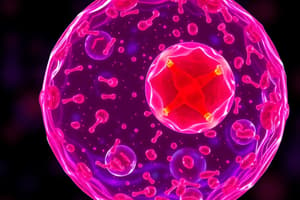Podcast
Questions and Answers
How does the initiation of the division phase (D-phase) in bacterial binary fission lead to septum formation?
How does the initiation of the division phase (D-phase) in bacterial binary fission lead to septum formation?
- Through the polymerization of FtsZ proteins into a Z-ring at the cell's midpoint, which constricts to form the septum. (correct)
- By inhibiting the synthesis of FtsZ proteins, preventing Z-ring assembly.
- By the aggregation of ribosomes at the midpoint, physically blocking division.
- Via the activation of DNA polymerase III, leading to rapid chromosome segregation and immediate cell separation.
In binary fission, what is the significance of the B-period (Interval phase) relative to the R-phase (Replication phase) and D-phase (Division phase)?
In binary fission, what is the significance of the B-period (Interval phase) relative to the R-phase (Replication phase) and D-phase (Division phase)?
- It is defined by active metabolism, biosynthesis and partitioning of cellular components equally between daughter cells.
- It signifies a preparatory stage for the next replication cycle after cell division. (correct)
- It involves the simultaneous replication and segregation of the bacterial chromosome.
- It represents a period of dormancy where the cell does not engage in division or replication.
How do senescent cells differ from quiescent cells in the context of the cell cycle?
How do senescent cells differ from quiescent cells in the context of the cell cycle?
- Quiescent cells are permanently removed from the cell cycle and are not capable of dividing again, unlike senescent cells.
- Senescent cells can re-enter the cell cycle under specific growth conditions, whereas quiescent cells cannot.
- Senescent cells are ageing or deteriorating and cannot re-enter the cell cycle, while quiescent cells are dormant but can re-enter. (correct)
- Both senescent and quiescent cells are capable of re-entering the cell cycle but do so at different rates.
What distinguishes specialized cells like neurons and red blood cells from liver or epithelial cells with respect to the cell cycle?
What distinguishes specialized cells like neurons and red blood cells from liver or epithelial cells with respect to the cell cycle?
In a typical rapidly proliferating human cell with a 24-hour cycle, if the S phase were experimentally prolonged by 4 hours, what would be the most likely compensatory change in the cell cycle duration to maintain viability?
In a typical rapidly proliferating human cell with a 24-hour cycle, if the S phase were experimentally prolonged by 4 hours, what would be the most likely compensatory change in the cell cycle duration to maintain viability?
How does the function of FtsZ proteins in bacterial cell division differ from the role of the mitotic spindle in eukaryotic cell division?
How does the function of FtsZ proteins in bacterial cell division differ from the role of the mitotic spindle in eukaryotic cell division?
Considering the factors that influence a cell's decision to enter the S phase, what cellular conditions would most likely trigger premature, but incomplete, DNA replication?
Considering the factors that influence a cell's decision to enter the S phase, what cellular conditions would most likely trigger premature, but incomplete, DNA replication?
If a bacterial cell's D-period (division phase) is artificially extended, what is the most likely consequence for its daughter cells?
If a bacterial cell's D-period (division phase) is artificially extended, what is the most likely consequence for its daughter cells?
How might the disruption of the metabolic sensor in a bacterial cell influence its division and subsequent cell size?
How might the disruption of the metabolic sensor in a bacterial cell influence its division and subsequent cell size?
What role does the MinC protein play in the disassembly of the Z-ring during bacterial cell division, and how does its action ensure proper septum formation?
What role does the MinC protein play in the disassembly of the Z-ring during bacterial cell division, and how does its action ensure proper septum formation?
Which of the following events is most dependent on having completed the G1 phase?
Which of the following events is most dependent on having completed the G1 phase?
If a cell experiences a mutation that prevents the duplication of centrioles during the S phase, what would be the most likely consequence for subsequent cell divisions?
If a cell experiences a mutation that prevents the duplication of centrioles during the S phase, what would be the most likely consequence for subsequent cell divisions?
How does the regulation of the cell cycle in cells with high mitotic activity (e.g., hematopoietic stem cells) differ from that in cells that require a specific stimulus to divide (e.g., liver cells)?
How does the regulation of the cell cycle in cells with high mitotic activity (e.g., hematopoietic stem cells) differ from that in cells that require a specific stimulus to divide (e.g., liver cells)?
Consider a population of somatic cells that are mostly in the G0 phase. What interventions would be most effective in stimulating these cells to re-enter the cell cycle and begin dividing?
Consider a population of somatic cells that are mostly in the G0 phase. What interventions would be most effective in stimulating these cells to re-enter the cell cycle and begin dividing?
How does the cell cycle of a prokaryotic cell undergoing binary fission fundamentally differ from the cell cycle of a eukaryotic cell?
How does the cell cycle of a prokaryotic cell undergoing binary fission fundamentally differ from the cell cycle of a eukaryotic cell?
Following exposure to a mutagen, a cell activates its DNA damage checkpoint in the G2 phase. What is the most likely immediate outcome of this activation?
Following exposure to a mutagen, a cell activates its DNA damage checkpoint in the G2 phase. What is the most likely immediate outcome of this activation?
If a mutation in a eukaryotic cell caused the G1 phase to be significantly shortened, what would be the most likely consequence?
If a mutation in a eukaryotic cell caused the G1 phase to be significantly shortened, what would be the most likely consequence?
How would a mutation affecting the 'restriction point' in a eukaryotic cell's G1 phase likely influence cell division?
How would a mutation affecting the 'restriction point' in a eukaryotic cell's G1 phase likely influence cell division?
What is the outcome if the Z-ring assembles asymmetrically instead of assembling at the midpoint of the cell?
What is the outcome if the Z-ring assembles asymmetrically instead of assembling at the midpoint of the cell?
Which event occurs during the S phase of the cell cycle?
Which event occurs during the S phase of the cell cycle?
Flashcards
Cell Cycle Definition
Cell Cycle Definition
The life cycle of a cell; the period between successive divisions.
Binary Fission
Binary Fission
Normal life cycle of a bacterial cell involving replication, division, and interval phases.
Replication Phase (R-phase)
Replication Phase (R-phase)
The duration to replicate the bacterial genome.
Division Phase (D-phase)
Division Phase (D-phase)
Signup and view all the flashcards
FtsZ Proteins Role
FtsZ Proteins Role
Signup and view all the flashcards
Interval Phase (I-phase)
Interval Phase (I-phase)
Signup and view all the flashcards
G1 phase
G1 phase
Signup and view all the flashcards
S Phase
S Phase
Signup and view all the flashcards
G2 Phase
G2 Phase
Signup and view all the flashcards
M Phase
M Phase
Signup and view all the flashcards
G0 Phase
G0 Phase
Signup and view all the flashcards
Quiescent Cells (dormant)
Quiescent Cells (dormant)
Signup and view all the flashcards
Study Notes
- The cell cycle is a cell's life cycle, i.e. the period between successive cell divisions.
The Cell Cycle in Prokaryotes
- Binary fission is the standard life cycle for bacterial cells.
- It involves three phases:
- Replication phase (R-phase = C-period)
- Division phase (D-phase = D-period)
- Interval phase (I-phase = B-period)
- During the Replication phase (R-phase = C-period), the bacterial genome replicates in a period of time such as 40 minutes for E. coli, resulting in a new chromosome with its own point of attachment to the membrane.
- During the Division phase (D-phase = D-period), the daughter chromosomes and other cellular components segregate into daughter cells.
- This phase is initiated by the FtsZ proteins, which assemble into a Z-ring at the cell's midpoint, leading to the formation of a septum.
- The Interval phase (I-phase = B-period) is the period between division and the beginning of chromosome replication.
The Cell Cycle in Eukaryotes
- Highly specialized cells like red blood cells and neurons cannot divide.
- Liver cells and lymphocytes can be induced to divide by a specific stimulus.
- Cells with high mitotic activity include hematopoietic stem cells and epithelial cells.
- Interphase consists of the G1, S, and G2 phases.
- For a typical rapidly proliferating human cell with a total cycle time of 24 hours:
- The G1 phase lasts about 11 hours
- The S phase lasts about 8 hours
- The G2 phase lasts about 4 hours
- The M phase lasts about 1 hour
- G1 phase is a gap phase after cell division, and the duration of the G1 phase is highly variable, even among cells of the same species
- During the S phase is the DNA synthesis phase, when DNA replication occurs, doubling the amount of DNA in the cell, and centrioles duplicate
- G2 phase is the gap phase after DNA synthesis and before cell division, where the cell conducts checks before entering the M phase.
- M phase is when the cell actually divides.
- The Go phase is the "resting phase", where most differentiated cells in a multicellular organism "exit" the cell cycle and can survive for extended periods, like nerve cells and eye lens cells.
- Some Go cells can re-enter the cell cycle and replicate, and these cells may be quiescent (dormant) or senescent (aging/deteriorating).
- Quiescent cells can re-enter the cell cycle, but senescent cells cannot.
- Most somatic cells in an organism are differentiated and quiescent, residing in the Go phase.
Studying That Suits You
Use AI to generate personalized quizzes and flashcards to suit your learning preferences.




